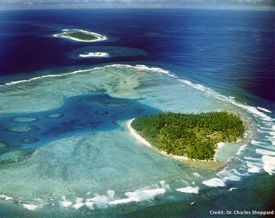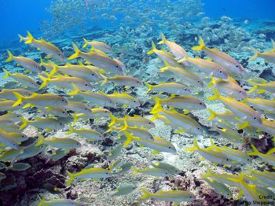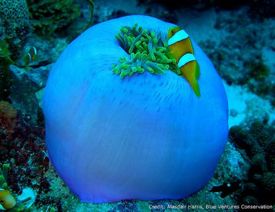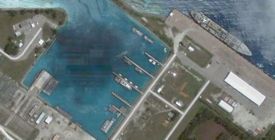The World’s Largest Water Park
Air Date: Week of February 26, 2010

Middle Brother Island is one of the more than 50 islands that make up the Chagos archipeligo. (Photo: Anne & Charles Sheppard)
British Prime Minister Gordon Brown is considering setting aside a pristine patch of the Indian Ocean as the world's largest marine sanctuary. Rachel Jones, a researcher at the London Zoological Society Aquarium, has been an advocate for establishing the park. Host Jeff Young speaks with her about the tuna boats, military base and Chagosian people that would be affected by the proposed sanctuary.
Transcript
YOUNG: Now we go a bit farther out to sea. British Prime Minister Gordon Brown will soon decide on what could be the world’s largest marine sanctuary – 210 thousand square miles around the Chagos islands. The 60-some British-owned Chagos Islands lie about a thousand miles southwest of India – they include the U.S. naval base of Diego Garcia. They also include some of the planet’s most pristine reef waters – and Rachel Jones, a researcher at London Zoo’s aquarium – has been there.

Advocates say restricting fishing in the Chagos marine sanctuary will increase fishable populations around the preserve. (Photo: Anne & Charles Sheppard)
So when you jump off a boat in the Chagos, you see these enormous fish coupled with the fact that the fish are not nearly as scared of you as they should be by rights, and then as you drop down and swim over the reef you see an incredible biodiversity. It’s an ecosystem that is pretty much intact, and that’s unusual so it’s very much like going back in time, jumping off a boat 50 years ago when reefs were really, really in good shape.
YOUNG: Well, if the area’s already healthy and in good shape, why is a special protection important?
JONES: The Chagos at the moment has a degree of de-facto protection from the British government, but there is also some exploitation. There are two tuna fisheries that operate in the area, and for about a month of the year they’re in the waters around the Chagos Islands catching tuna. And along with the tuna that they mean to catch there’s a huge number of fish that they also take as by-catch, and they’re usually things like billfish and lots and lots of sharks.

(Photo: Alasdair Harris, Blue Ventures Conservation)
JONES: There’s a fair bit of good evidence that marine protected areas have an impact. In the relatively short term we can start to see some populations of fish bounce back within a few years, certainly within five to ten years we’re seeing very much increased populations of fish. And this has a knock-on effect for people fishing around a marine protected areas, so even though the area within which they’re free to fish may be reduced, their catches may actually go up, which is slightly counterintuitive.
The benthic animals like corals, the ones that are attached to the bottom, take a little bit longer, and when you start to see the reef-forming corals building back up again you’re really talking about the trees in the forest – these are the animals that make the reef, itself, they make the habitat that all the other animals – fish and other invertebrates – rely on.
YOUNG: It seems to me that most people who’ve been to this place have probably been there as part of the military because of the base on Diego Garcia. How does that effect the decision that your prime minister faces here – the fact that there is this important military base there?
JONES: That’s right, there’s certainly the suggestion that you could effectively ring fence Diego Garcia and have that off to one side. I’m certainly not in a position to comment on that whether that would happen politically or militarily, but yes, there is a long-term commitment to keep Diego Garcia going as a military base. In fact, on Diego Garcia there are large areas of the island which are again de-facto and in some cases statutory protection as various nature reserves and restricted areas.

Diego Garcia, once home to the Chagosian people, now hosts about 1,700 US military personnel and 1,500 civilian contractors. (Photo: Google Maps)
YOUNG: Now the history of the military base is interesting in that the people who once lived on Diego Garcia were essentially evicted, moved to other islands to make way for the military base. What about those people? I mean don’t they have some say in that island and what should become of it as part of a potential marine sanctuary?
JONES: Yes, and what the network I represent said very clearly is the environmental protection of these fantastic areas really is in everybody’s best interest, whatever the future may hold – in terms of the Chagosian people and their possible resettlement, they’ve got a case with the European courts at the moment, which is pending and who can say what the outcome will be? But I very much believe that the case we’re making now for environmental protection is very much without prejudice to the case they’re making for resettlement.
YOUNG: Now, here in the U.S. president Bush made a pretty big splash, pardon the pun, in the last months of his presidency by declaring what at the time was the world’s largest marine sanctuary, but as I understand it, this one – if prime minister Brown decides to make this a sanctuary – it would be bigger, right?
JONES: That’s right, it would. It would be the world’s biggest. But, Bush’s rather last minute declaration of that sanctuary was incredibly impressive. I think it surprised a few people over here, but it was actually quite inspirational. If Gordon Brown were to follow the idea of declaring the entire area protected, it would increase the percentage of a strictly protected area in the world’s oceans by 20 percent. And he could literally do that overnight – it’s an incredible, exciting opportunity.
YOUNG: So, Mr. Brown could look pretty green by protecting a big patch of blue? Do I understand that correctly?
JONES: [Laughs] Yes, something along those lines!
YOUNG: Rachel Jones is with the London Zoological Society Aquarium. She’s been telling us about the Chagos Islands. Thanks very much.
JONES: Thank you.
[MUSIC: David Byrne/Brian Eno “Strange Overtones” from Everything That Happens Will Happen Today (Todomundo Records 2009)]
YOUNG: Just ahead – how to handle some of the most dangerous waste on the planet – keep listening to Living on Earth!
Links
Living on Earth wants to hear from you!
Living on Earth
62 Calef Highway, Suite 212
Lee, NH 03861
Telephone: 617-287-4121
E-mail: comments@loe.org
Newsletter [Click here]
Donate to Living on Earth!
Living on Earth is an independent media program and relies entirely on contributions from listeners and institutions supporting public service. Please donate now to preserve an independent environmental voice.
NewsletterLiving on Earth offers a weekly delivery of the show's rundown to your mailbox. Sign up for our newsletter today!
 Sailors For The Sea: Be the change you want to sea.
Sailors For The Sea: Be the change you want to sea.
 The Grantham Foundation for the Protection of the Environment: Committed to protecting and improving the health of the global environment.
The Grantham Foundation for the Protection of the Environment: Committed to protecting and improving the health of the global environment.
 Contribute to Living on Earth and receive, as our gift to you, an archival print of one of Mark Seth Lender's extraordinary wildlife photographs. Follow the link to see Mark's current collection of photographs.
Contribute to Living on Earth and receive, as our gift to you, an archival print of one of Mark Seth Lender's extraordinary wildlife photographs. Follow the link to see Mark's current collection of photographs.
 Buy a signed copy of Mark Seth Lender's book Smeagull the Seagull & support Living on Earth
Buy a signed copy of Mark Seth Lender's book Smeagull the Seagull & support Living on Earth

